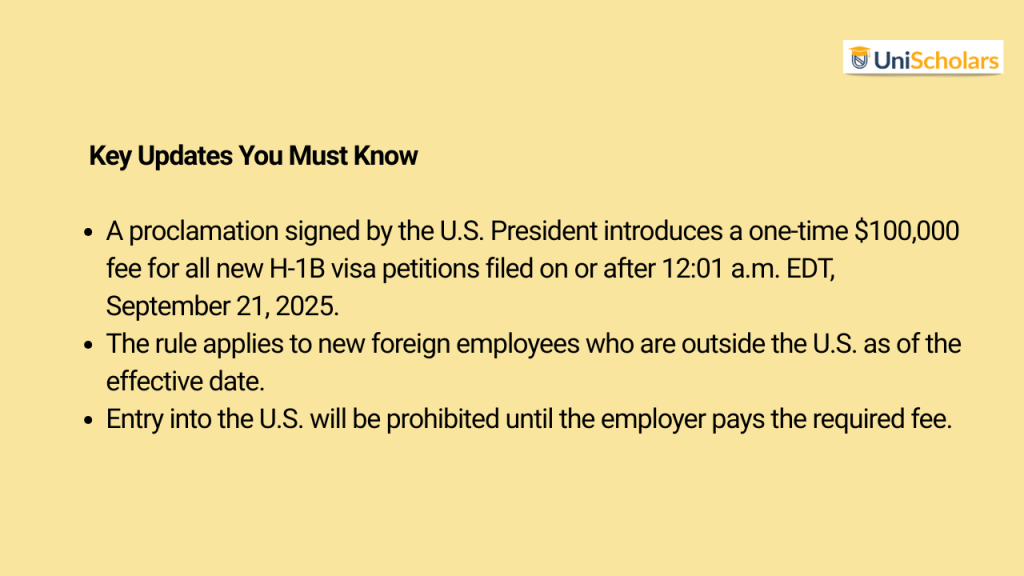Table of Contents
ToggleThe H-1B visa is one of the most popular pathways for skilled professionals to build a career in the United States. Created for speciality occupations requiring advanced knowledge, it connects U.S. employers with global talent while offering international workers valuable opportunities to live and work in America.
Each year, thousands of applicants, ranging from graduates to experienced professionals, compete for this visa, making the process highly selective. This blog provides comprehensive coverage of everything you need to know, including eligibility, requirements, costs, timelines, and the application process.

What Is The H1B Visa?
The H-1B visa is a non-immigrant visa that allows U.S. employers to temporarily hire foreign professionals in specialised fields requiring technical expertise and a bachelor’s degree (or its equivalent). It is commonly issued in industries such as engineering, information technology, healthcare, and other specialised sectors. International students who complete their education in the U.S. are also eligible to apply for the H-1B visa, making it a popular pathway for those seeking to continue working and advancing their careers in the country.
Benefits Of The H1B Visa To Employers And Employees
The H-1B visa offers significant advantages to both U.S. employers and foreign professionals. While companies gain access to specialised talent and strengthen their global competitiveness, employees benefit from career opportunities, fair wages, and a clear pathway to long-term residency.
| For Employers | For Employees (H-1B Holders) |
| Access to a global pool of skilled talent to fill gaps in industries like tech, healthcare, and hospitality. | Work authorisation in the U.S. for 3 years, renewable up to 6 years (with possible further extensions). |
| A diversified workforce enhances innovation, global competitiveness, and entry into non-English-speaking markets. | Guaranteed prevailing wages, often higher than domestic averages. |
| Helps companies stay competitive globally by hiring top international professionals for specialised roles. | Flexibility to change employers with a new H-1B petition. |
What Are The H1B Visa Requirements?
Requirements For Employers
Employers play a crucial role in the H-1B visa process. To hire foreign professionals under this programme, they must meet specific requirements set by U.S. immigration and labour laws. These ensure fair wages, protect U.S. workers’ rights, and establish a legitimate employer-employee relationship.
| Requirement | Details |
| Specialty Occupation | The employer must be able to demonstrate that the position is for a speciality occupation. This role requires specialised knowledge and the relevant degree. |
| Labour Condition Application (LCA) | Employers must file with the U.S. Department of Labour. H-1B workers must be paid the wages as others who have similar qualifications and experiences.Hiring must not harm the working conditions of U.S. workers.No strike, lockout, or layoff can exist in the role at the time of filing. |
| Sponsorship & Petition | Employers must sponsor the worker by filing Form I-129 (Petition for a Nonimmigrant Worker) with USCIS. |
| Employer-Employee Relationship | A valid relationship must exist, with the employer having authority to hire, fire, and supervise the worker. |
| H-1B Lottery Registration | Employers subject to the visa cap must complete electronic registration for the H-1B lottery. |
Requirements For Employees
To qualify for an H-1B visa, employees must meet specific criteria that demonstrate their education, skills, and eligibility for a speciality occupation. These requirements ensure that applicants are suitably qualified and maintain compliance throughout their employment in the U.S.
| Requirement | Details |
| Educational Qualification | Must hold at least a bachelor’s or higher degree, or a US equivalent, in the speciality field. |
| Job Offer | Must have a valid job offer from a U.S. employer in a speciality occupation. |
| Work Experience | Relevant skills and experience are essential, demonstrated through past projects, roles, and academic achievements aligned with the speciality occupation. |
| Visa Status | Must maintain a valid H-1B visa status throughout employment. |
| Licensing | Relevant skills and experience are essential, demonstrated through past projects, roles, and academic achievements aligned with the speciality occupation. |
Document Checklist To Apply For an H1-B Visa

For the Employer
- Form I-129 (Petition for a Nonimmigrant Worker): Filed by the employer to initiate the H-1B process.
- Labour Condition Application (LCA): Submitted by the employer to the Department of Labour, confirming fair wages and working conditions.
- Job Offer Letter: A formal employment offer from the U.S. employer outlining the role and position.
- Employer’s Business Documentation: Evidence of the employer’s financial stability and organisational structure.
For the Employee
- Degree Certificates: Proof of the employee’s academic qualifications (Bachelor’s degree or higher).
- Academic Transcripts: Official records of completed coursework, provided by the employee.
- Resume / CV: A detailed overview of the employee’s professional background, skills, and experience.
- Passport: A valid passport belonging to the employee, with sufficient validity to cover the visa period.
- Passport Photographs: Recent passport-sized photos that meet U.S. visa specifications.
How Do You Apply For The H-1B Visa?
The H-1B visa application process for 2025 involves several key steps, primarily driven by the employer sponsoring the worker. The main steps are:
Step 1: Secure a Job Offer
The journey begins with a job offer from a US employer in a speciality occupation. The employer must agree to sponsor your H-1B visa, which legally allows them to initiate the petition process on your behalf. Without this sponsorship, you cannot apply for the H-1B independently.
Step 2: Employer Registers for the H-1B Lottery
During the annual registration period (usually March), the employer creates an online USCIS account and registers your details. If the number of registrations exceeds the yearly cap, USCIS runs a random lottery. Only those selected in the lottery are invited to move forward with a full petition.
Step 3: File the Labour Condition Application (LCA)
Next, the employer must submit an LCA to the US Department of Labour. This document confirms two things: that you will be paid at least the prevailing wage for your role, and that hiring you will not disadvantage American workers. The LCA is a mandatory safeguard for fairness in the labour market.
Step 4: File Form I-129 Petition)
Once the LCA is approved, the employer files Form I-129, Petition for a Nonimmigrant Worker, with USCIS. This includes the certified LCA, proof of your educational qualifications, the official job offer, and other supporting evidence. Petition filing fees must also be paid at this stage.
Step 5: USCIS Reviews Petition
USCIS carefully examines the petition and may issue a Request for Evidence (RFE) if more information is needed. If the petition is approved, you move on to the visa application phase. If denied, the process ends unless an appeal is filed.
Step 6: Apply for a Visa (if outside the US)
Applicants already in the US can begin work after petition approval, but those abroad must attend a consular visa interview. This involves filling out Form DS-160, paying the visa fee, and presenting your case before a consular officer, who makes the final call on approval.
Step 7: Enter the US and Begin Working
With the visa approved, you can travel to the US up to ten days before your employment start date. Once in the country, you may officially begin work on the date stated in your petition.
Understanding The Costs Involved With The H-1B Visa
The overall cost of an H-1B visa depends on several factors, including the size of the employer, optional services like premium processing, specific legal criteria, and attorney fees. Below is a complete breakdown of the costs associated with the H-1B process, covering what is paid by the employer, the employee, and any optional attorney fees.
Fees Paid By The Employer
As per the new proclamation signed by President Trump, a new $100,000 application fee will be applicable to new H-1B applicants starting September 21, 2025.
| Fee Type | Amount (USD) | Details |
| Registration Fee | $215 | Mandatory for all employers. |
| Basic Filing Fee (Form I-129) | $780 (standard) | $460 for small employers and nonprofits. |
| ACWIA Training Fee | $750 | For employers with 1–25 full-time employees. |
| $1,500 | For employers with 26+ full-time employees. | |
| Exempt | Exempt if: higher education institutions, nonprofits affiliated with higher ed, nonprofit/government research orgs, primary/secondary schools, or nonprofits with curriculum-related clinical training programs. | |
| Fraud Prevention & Detection Fee | $500 | Applies to new H-1B petitions or a change of employer. |
| Asylum Program Fee | $600 | For employers with 26+ full-time employees. |
| $300 | For small employers ( with fewer than or equal to 25 full-time employees). | |
| $0 | For nonprofit organisations. | |
| Public Law 114-113 Fee | $4,000 | Only for companies with more than 50 employees and at least half of whom are on H-1B or L-1 visas, USCIS may exempt. |
| New One-Time Fee | $1,00,000 | This applies to all new H-1B petitions. |
| Premium Processing (Optional) | $2,805 | Expedites processing to 15 days (Form I-907 required for this). |
Fees Paid By The Employee
Below are optional fees that an employee might have to pay under certain circumstances.
| Optional Fee Type | Amount (USD) | Details |
| Premium Processing (Form I-907) | $2,805 | Paid by the employer or employee. Optional service to expedite H-1B processing to 15 days. For an Employee, this fee is paid when faster processing is needed for personal reasons. |
| H-4 Dependent Fees | $470 (filing fee)$850 (legal fee) | Paid when family members (spouse/children) apply to be H-4 dependents of the employee using Form DS-160. |
The Attorney Fees
Attorney fees for the H-1B visa can vary significantly depending on the law firm handling the case. Not every company will need to incur the same costs, as the filing process is now tiered into distinct stages. The typical structure is outlined below:
| Stage / Item | Amount (USD) | Notes / Inclusions |
| Stage One – Initial Registration | $300 | Covers the registration process and all required preliminary case analyses. |
| Stage Two – Case Filing (if selected in lottery) | $2,600 | Includes preparation of all forms, support letters, and case filing within the timeframe. |
| Request for Evidence (RFE) Response (if applicable) | $500 – $1,600 | Additional cost incurred if USCIS issues an RFE for the case. |
What Is The H-1B Visa Cap ?
The H-1B visa cap is the annual numerical limit set by the U.S. government on the number of new H-1B visas that can be issued each fiscal year. Congress currently sets this cap at:
- Regular Cap: 65,000 visas are under the regular cap for most applicants. Applicants must at least hold a bachelor’s degree or its equivalent.
- Master’s Cap: 20,000 additional visas under the master’s cap for applicants who hold a U.S. master’s degree or higher from an accredited institution.
Now that we understand what the H-1B visa cap is, let us discuss the H-1B lottery system.
What Is The H-1B Lottery System?
The H-1B lottery system is a random selection process used by the US Citizenship and Immigration Services (USCIS) when the number of H-1B visa applications surpasses the annual cap limits.
- Regular Lottery: USCIS randomly selects 65,000 applicants subject to the regular H-1B cap.
- Master’s Degree Lottery: A second round randomly selects an additional 20,000 applicants holding a US master’s degree or higher.
H-1B Visa Processing Timeline

The H-1B visa process involves several stages, and the overall timeline can vary depending on factors such as the annual cap, USCIS workload, and whether premium processing is used. While some applicants may see approvals in as little as 3–4 months, others may wait 6–9 months or longer. Below is a typical breakdown of the process:
1. Registration Period
- It opens in early March each year and typically lasts for approximately 2-3 weeks.
- Employers submit registrations electronically during this time.
- USCIS publishes the official dates annually.
2. Lottery Selection
- This step takes around 1 – 2 weeks.
- If the number of registrations exceeds the annual cap (65,000 regular cap + 20,000 master’s cap), USCIS conducts a random lottery.
- Selection notices are issued shortly after the registration window closes.
3. Petition Filing Window
- Selected applicants have 90 days to file their complete H-1B petition (Form I-129) along with supporting documents and fees.
4. USCIS Processing
- Regular Processing: Typically takes 3 – 6 months, depending on service centre workload.
- Premium Processing (Optional): Guarantees a decision (approval, denial, or RFE) within 15 business days of USCIS receiving Form I-907 and the premium fee.
5. Request for Evidence (if issued)
- If USCIS requires additional documentation, a Request for Evidence (RFE) is sent.
- Responding to an RFE can add weeks or months to the timeline.
6. Final Decision
- USCIS will either approve or deny the petition.
- Approved petitions allow the employee to move forward with visa stamping (if outside the U.S.) or a change of status (if already in the U.S.).
The H-1B visa is a bridge between U.S. employers seeking specialised skills and international professionals aiming to grow their careers. Although the process can seem complex, understanding the requirements, fees, caps, and timelines helps both employers and employees prepare more effectively. With the right planning, documentation, and awareness of policy updates, you can set yourself up for success. And if you are a student planning to study abroad, UniScholars is here to support you with expert counselling and guidance.
FAQs
Q.1 What is the new H-1B visa cost?
Ans: As of September 21, 2025, a new $100,000 application fee applies to all new H-1B petitions, in addition to existing USCIS filing fees. The total cost now varies depending on employer size, required fees, and optional services like premium processing.
Q.2 Who pays for an H-1B visa?
Ans: Most mandatory fees, such as the filing fee, ACWIA fee, fraud fee, and the new $100,000 fee, must be paid by the employer. Optional costs like premium processing or visa stamping (MRV fee) may be paid by the employee.
Q.3 Who is eligible for the H-1B visa?
Ans: The H-1B visa is for foreign professionals employed in a speciality occupation requiring theoretical or technical expertise, typically backed by a bachelor’s degree or higher. U.S. employers must sponsor the visa on behalf of the applicant.
Q.4 What are the H-1B visa requirements for indian citizens?
Ans: Indian citizens must have at least a bachelor’s degree or equivalent work experience in a speciality field, a valid job offer from a U.S. employer, and an approved LCA. They must also hold a valid passport and meet all USCIS eligibility and documentation requirements.
Q.5 How long can you stay in the US on an H-1B?
Ans: You can stay in the US on an H-1B visa for an initial period of up to 3 years, which can typically be extended to a maximum of 6 years. In some cases, further extensions are possible if a green card process is underway.
Q.6 Can you bring your family if you have an H-1B visa?
Ans: Yes, H-1B visa holders can bring their immediate family (spouse and unmarried children under 21) to the US on H-4 dependent visas. H-4 beneficiaries are only eligible to be in the U.S. in H-4 status while the principal H-1B beneficiary is in the U.S. in valid H-1B status.
Q.7 What are the disadvantages of an H-1B visa?
The H-1B visa has drawbacks, including limited validity (3–6 years), dependence on the sponsoring employer, and uncertainty due to the lottery system. It also restricts work opportunities for family members and can involve delays in extensions or green card processing.

















1 thought on “Top PGDM Courses In Canada: Universities & Eligibility”
I have done Bachelor’s in Culinary Arts from India and completed my graduation in the year 2022 .I am 22 years old. After graduation, I have done 1 year paid internship from USA .Now, I would like to take occupational experience and learn culinary skills and also do masters in Culinary arts.How can I find the college n best course / country where I can persue studying further